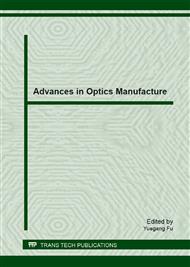p.281
p.287
p.292
p.298
p.305
p.313
p.319
p.325
p.329
Dual-CCD Complete Stokes Simultaneously Imaging Polarimeter and Experimental Data Analysis
Abstract:
Polarization imaging technology that is on the basis of the polarization measurement can change the obtained polarization information into two-dimensional image, from which we can acquire polarization characteristics of target scene just like normal gray image so that this technique is widely used in the fields of military investigation, medical testing, space exploration, meteorology and so on. Traditional imaging polarimeter is time sequence polarization imaging, which is to use sequential rotational polarization components (line polarizer or wave plate etc.) and to combine Fourier analysis method to acquire final Stokes components. But because of the sacrificing of temporal resolution, this technique does not meet the needs of the situation of high-speed dynamic changing scene. While current simultaneously polarization imaging technique commonly uses multiple sets of optical systems and at least four CCD cameras, which have the problems of low energy utilization rate and non-matching performance among the optical sets. To solve the aforementioned problems, we design and implement a set of non-mechanical rotating parts, double Wollaston prisms-based high resolution simultaneously imaging polarimeter. This system uses the specific combination of non-polarizing beam splitter, Wollaston prisms and wave plates to divide the incident target space beam into four optical paths of different polarization states which can be taken into two types: two paths in the reflection part and two paths in the transmission part. Finally the imaging lens converge the beam to different regions of two large array CCD to image four images. To achieve the goal of extracting complete Stokes information, we apply the Stokes vector and Mueller matrix analysis. The article presents systems structure, working theory, calibration method, experiment data analysis and system polarization performance, which provides a good reference for the simultaneously high-speed polarization imaging.
Info:
Periodical:
Pages:
305-312
Citation:
Online since:
May 2013
Price:
Сopyright:
© 2013 Trans Tech Publications Ltd. All Rights Reserved
Share:
Citation:


